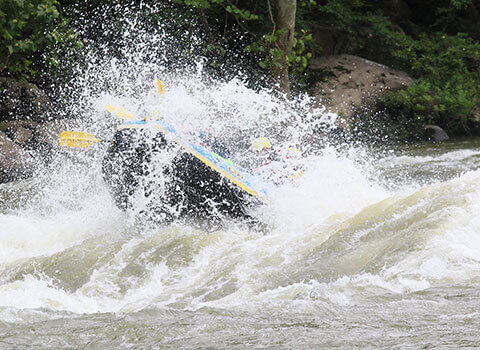In whitewater rafting, practice and experience play a huge part in developing the skills required to become a more adept rafter. However, with the winter cold setting in, it is important that both new and experienced rafters keep their head in the rafting game, even when they can’t get onto the water.
An important part of developing any skill is to understand and use the correct terms. While some veteran rafters may see these words as second nature, it can never hurt to go back and review the terms! Beginning rafters can also strengthen their skills for springtime by honing their vocabulary skills ahead of time.
Below we have some essential rafting terms. This list is far from exclusive, so leave a comment with any other additional words and definitions that you think are important!
Here are some essential terms to know and remember for rating.
Eddy:
An eddy is a part of the river that forms downstream of an obstruction. The water in the eddy is flowing in the opposite direction of the river and can be utilized to slow or stop the raft. In some cases, they can become powerful and may have a negative effect on rafts.
Flow:
The flow is the current volume of the river – which is measured in cubic feet per second. The United State Geologic Survey have created gauging stations where they record and publish flows from rivers around the country.
Rapid:
Rapids are formed in tight areas of the river where the surface of the river bed changes dramatically. They usually occur in short spurts and range in difficulty to negotiation. They are often what people think of when they think of white water rafting.
River Left and River Right:
These words are used to specify a side of the river to distinguish points of interest. River right or left always refer to the side of the river headed downstream. In other words, when you go downstream, “river right” is on the right and “river left” is on the left. This is then reversed when facing upstream.
High Side!:
This infrequently used (but still important) term is used by guides to help keep the boat upright. It is generally used immediately before large waves, and mandates the crew to lift the upstream side of the raft in time to allow the current to pass under the raft. It often prevents the raft from becoming stuck on a rock or also from rolling over.
Biner:
Shorthand for Carabiner – or the little clip that is used to secure things to a raft.
D-Ring:
Metal, D-shaped ring attached to a raft to help secure lines, rope, frames and other essentials.
Perimeter Line:
The line that travels through all the D-rings along the perimeter of the raft. This serves as a secure line for anyone that falls out to pull themselves back in with.
Whitewater rafting is a fun and exciting sport for people of all ages and walks of life. Knowing some terms before your first trip can help to prepare you, but it is still important to pay attention to the instructions that your guide is giving you.






